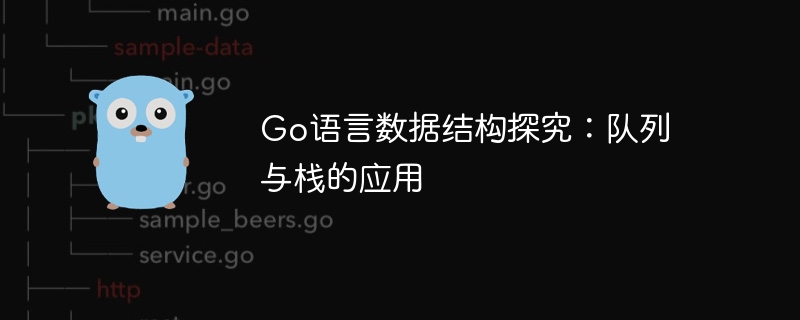
In the Go language, the queue follows the first-in-first-out (FIFO) principle and is implemented using the list package in the standard library. It is often used in messaging systems; the stack follows the last-in-first-out (LIFO) principle and is often used for function call tracking and bracket matching. , which can be implemented using slices.

Go language data structure talk: application of queue and stack
Queue
Queue is a data structure that adheres to the first-in-first-out (FIFO) principle. This means that the earliest elements entered into the queue will be removed first. Queues are useful in the following scenarios:
Go Implementation of queues in the language
The most common way to implement queues in the Go language is to use container/liststandard library package:
import (
"container/list"
)
// 定义队列类型
type Queue struct {
items *list.List
}
// 创建队列
func NewQueue() *Queue {
return &Queue{
items: list.New(),
}
}
// 进队
func (q *Queue) Enqueue(item interface{}) {
q.items.PushBack(item)
}
// 出队
func (q *Queue) Dequeue() interface{} {
if q.IsEmpty() {
return nil
}
front := q.items.Front()
q.items.Remove(front)
return front.Value
}
// 判断队列是否为空
func (q *Queue) IsEmpty() bool {
return q.items.Len() == 0
}Practical combat Case: Message Queue
Message queue is a typical application scenario of queue. We can use the queue in the Go language to implement a message queue:
func main() {
// 创建消息队列
queue := NewQueue()
// 向队列发送消息
queue.Enqueue("消息 1")
queue.Enqueue("消息 2")
// 接收消息
for {
msg := queue.Dequeue()
if msg == nil {
break
}
fmt.Println(msg)
}
}Stack
The stack is a data structure that adheres to the last-in-first-out (LIFO) principle. This means that the last element added to the stack will be removed first. The stack is very useful in the following scenarios:
Implementation of stack in Go language
The simplest way to implement the stack in the Go language is to use slicing:
// 定义栈类型
type Stack []interface{}
// 进栈
func (s *Stack) Push(item interface{}) {
*s = append(*s, item)
}
// 出栈
func (s *Stack) Pop() interface{} {
if s.Empty() {
return nil
}
top := (*s)[len(*s)-1]
*s = (*s)[:len(*s)-1]
return top
}
// 判断栈是否为空
func (s *Stack) Empty() bool {
return len(*s) == 0
}Practical case: bracket matching
The stack is a checker for bracket matching Good tool:
func isBalanced(expr string) bool {
stack := Stack{}
for _, char := range expr {
if char == '(' || char == '[' || char == '{' {
stack.Push(char)
} else if char == ')' || char == ']' || char == '}' {
if stack.Empty() {
return false
}
top := stack.Pop()
if (char == ')' && top != '(') || (char == ']' && top != '[') || (char == '}' && top != '{') {
return false
}
}
}
return stack.Empty()
}The above is the detailed content of Research on Go language data structure: application of queue and stack. For more information, please follow other related articles on the PHP Chinese website!
 Usage of Type keyword in Go
Usage of Type keyword in Go
 How to implement linked list in go
How to implement linked list in go
 What are the Go language programming software?
What are the Go language programming software?
 How to learn go language from 0 basics
How to learn go language from 0 basics
 Usage of treenode
Usage of treenode
 What are the methods to implement operator overloading in Go language?
What are the methods to implement operator overloading in Go language?
 What are the operators in Go language?
What are the operators in Go language?
 What are the cloud operating systems?
What are the cloud operating systems?




